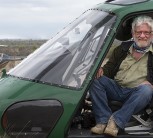A new series of maps drawn up by Emeritus Professor Rudi van Aarde of the University of Pretoria (UP) and Dr Ryan Huang of Duke University in the US details where African elephants prefer to roam in Southern Africa.
The maps illustrate the favourite terrain of elephants throughout Southern Africa, and the human and natural obstacles that make it impossible for populations in different regions to link up. The academics are both lead authors of a paper published in peer-reviewed science journal PLOS ONE that sets out and explains the series of maps.
Details of the whereabouts of the animals were drawn from the world’s largest database on elephant movement, which has been housed at UP’s Conservation Ecology Research Unit (CERU) in the Department of Zoology and Entomology since 2001.
“The maps help us to consider the prospects of how we can improve the connections between the different protected areas that harbour elephants in Southern Africa,” says Prof Van Aarde, who is also the Chair of CERU.
About 80% of all savannah elephants live in Southern Africa (which spans an area of 7 million square kilometres) within 900 000 square kilometres of eight separate clusters of protected land across eight countries. Each cluster has a primary protected area (like the Kruger National Park in the case of the Limpopo cluster) at its core, and is further surrounded by or connected to other protected areas.
The researchers mapped where elephants currently roam, where there are similar suitable habitats in terms of their preferences for specific vegetation and terrain, and areas where they could link up with other populations. They also noted natural obstacles such as rivers and hilly terrain, and human factors such as fences, settlements, grazing land and crop pastures that limit movement.
To add detail to these maps, the research team used 1.2 million data points from the CERU database. It was gathered over 20 years with telemetric collars and other tracking devices to monitor the movements of 261 elephants across Southern Africa.
“The maps tell us how and where elephants use a landscape, where they want to go and what they prefer,” Prof Van Aarde explains. “They also help to visualise how fences restrict the movement of elephants on a local scale.”
Prof Van Aarde adds that protected areas have played a huge role in increasing African elephant numbers. However, he is increasingly worried that the compression of elephants into designated conservation areas might also create problems.
“Confinement to protected areas and the fragmentation of the once continuous population have adverse demographic and genetic consequences for elephants; this goes against the first principles of conservation,” Prof Van Aarde and his collaborators wrote. “We urgently need a solution.”
Reconnecting natural areas and enlarging protected estates are possible solutions, and align with the guiding principles of the Global Deal for Nature, a plan proposed by researchers that outlines what it will take to maintain a liveable planet. Connecting existing protected areas with one another could ensure the viability and continued existence of populations of large-bodied herbivores, including elephants.
The research team realises that great effort and socio-political will is needed to make such connections.
“The effort will be worthwhile, as it will help to resolve many issues that people have with elephants as so-called ‘problem animals’,” Prof Van Aarde notes. “This includes degradation of the landscape in certain areas.”
“Our current network of protected areas provides a foundation, but long-term population stability will be difficult if elephants cannot disperse into other suitable areas,” Dr Huang says. “Therefore, we must protect the connections that we have identified in cooperation with local communities and governments, so that the animals can do so. That’s among our best chances at a sustainable future for elephants.”
Prof Van Aarde says the effort is about more than elephant conservation, and that the giants of the African bushveld are so-called “umbrella species” for the conservation of Southern African wildlife at large.
Click on the gallery in the sidebar to view the maps of elephant movement patterns.
Prof Rudi van Aarde
November 24, 2022

Emeritus Professor Rudi van Aarde obtained his undergraduate degree from the University of Pretoria (UP) and has been doing research at the University for the past 45 years.
He leads the Conservation Ecology Research Unit (CERU), a small group of scientists and technicians within the Department of Zoology and Entomology. The group is studying elephants.
His research matters, he says, because nature is the essence of life. He hopes to achieve a better world for elephants through his research.
Prof Van Aarde’s advice to school learners or undergraduate students who are interested in his field is to have passion for what they want to do. His main hobby, whether he is working or not, is photography.
 Story
Story
This edition is curated around the concept of One Health, in which the University of Pretoria plays a leading role globally, and is based on our research expertise in the various disciplines across healthcare for people, the environment and animals.
 Story
Story
Paediatric neurosurgeon Professor Llewellyn Padayachy, Head of the Department of Neurosurgery at the University of Pretoria’s (UP) Steve Biko Academic Hospital, is redefining how brain-related diseases are diagnosed and treated, especially in low-resource settings. He’s at the forefront of pioneering work in non-invasive techniques to assess and measure raised pressure inside the skull,...
 Infographic
Infographic
Africa faces immense challenges in neurosurgery, such as severe underfunding, a lack of training positions and a high burden of disease. There is one neurosurgeon per four million people, far below the WHO’s recommendation of one per 200 000. This shortage, compounded by the lack of a central brain tumour registry and limited access to diagnostics, severely impacts patient outcomes.
Copyright © University of Pretoria 2025. All rights reserved.
Get Social With Us
Download the UP Mobile App